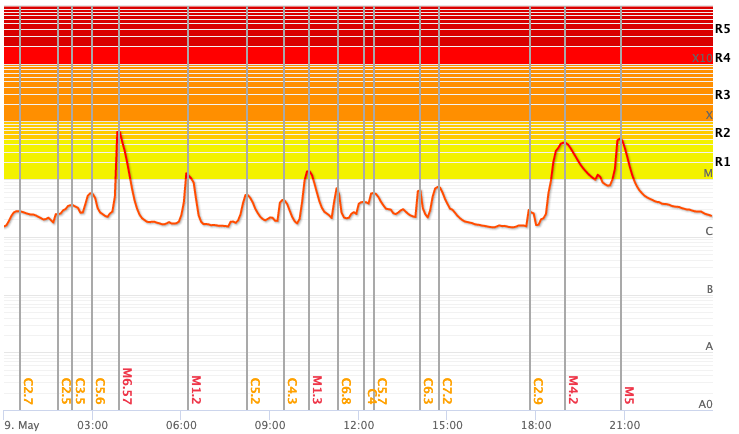The Sun Goes Pew Pew!
On 09 May 2023, an M6.5 flare (R2 level) caused a Moderate HF Blackout.

generated a severe geomagnetic storm at 19:26 UTC.
as seen at SpaceWeatherLive

The global view of 6m activity shows little effect from the flare.

10m activity was already depressed before the flare arrived, and decreased further after arrival. It's not clear whether the flare affected 10m.

20m activity may have been depressed slightly.

Like 10m, 30m was already below normal before the flare arrived. The flare did not appear to have much effect.

The 6m Video shows
Note1: the arcs on the video only indicate the fields of the sender and receiver, not the great circle path.
Note2: the local times shown above ignore daylight savings time, if observed.
We can "zoom in" on activity during the day, in specific Maidenhead fields.
Field PM
There is no apparent affect from the flare.


THe 10m spot count plot shows a decrease from about one hour before the flare's peak to about one hour after. The valley of this decrease coincide with the reported peak of the flare.


There is typically little 20m activity from this field at this time.


30m activity did not pick up like it usually does, right when the CME arrived.


Conclusion from PM data: the CME depressed propagation on 10m and 30m when it arrived, and may have co-contributed to inferior propagation.
Field JN
The 6m spot count from field JN shows an unusually high level of activity from 07:00 to 13:00 UTC. It also shows that JN sees very little activity on this band after about 19:00 UTC, so we can't draw any conclusions about the CME.


On 10m, activity begins to decline about 18:45, but doesn't show very unusual behavior until the normal range is near zero.


The effect of the CME can be seen in the 20m spot count plot. Activity began decreasing at 19:15, and was below the normal range by 19:40. It continued to decrease until 24:00.

The average distance dropped sharply when the CME arrived, but then recovered.

It's not clear that the CME affected the spot count on 30m, but there was a noticeable dip in the average distance in the 30 minutes before the CME arrived, though that recovered as 20m did.


Field JO
6m at JO was very similar to JN.


10m at JO was very similar to JN.


Activity began decreasing on 20m at 18:30, but was not abnormally low until 19:30 when the CME arrived. The CME's affect was cleared for the rest of the day.
The same was true of the average distances. Instead of the normal 6,000 km distance, the averge wandered around 1,500 km.


The behavior on 30m was similar to 20m, but muted.


Field IO








Field GF


Field GG






Field FN








Field EM








Field DM








Field EL


Field FE


Field FK


Conclusion:
Explanation:











































































